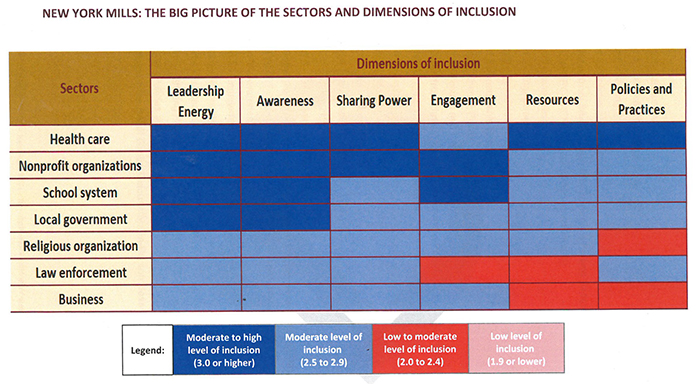NYM Welcoming Committee unveils survey results
News | Published on January 30, 2024 at 4:11pm GMT+0000 | Author: Tucker Henderson
0
Community sectors were given a score of inclusivity relating to six different dimensions of inclusion in their everyday operations. Scores ranged from 3.3 to 2.1 on a scale of 0 to 4.
By Tucker Henderson
Reporter
The ongoing Welcoming Communities Cohort met on Wednesday, Jan. 24 to share the results of the surveys that were available around the community and online from November 15 to January 7. Through facilitation by the University of Minnesota, the assessment has been analyzed and the results were shared at the meeting.
The surveys, which were open to anyone who felt that they were a member of the New York Mills community and asked questions about the inclusivity of seven sectors of the community.
A total of 284 surveys were completed, with the ability to complete multiple surveys, especially in separate sectors. Questions addressed awareness, engagement, resources, leadership energy, sharing power and policies and practices for including diverse populations within each sector. The median length of residence in the community by survey takers was 32 years (a range from 1 year to 80 years).
While most of the sectors received anywhere from 22 to 31 completed surveys, health care received a few more at 43 and the school sector received the most at 80 completed assessments.
“That’s a fantastic number given the size of the community,” said Ellen Wolter, facilitator through the University of Minnesota.
Wolter said that the city of Fergus Falls, which has also recently undertaken the assessment, had around 400 completed assessments while having almost 11 times the population of NY Mills.
A score of inclusivity was given to each sector in each of the six dimensions of inclusion: awareness, engagement, sharing power, leadership energy, resources, and polices and practices. Every sector scored fairly high, with slightly lower scores for a few sectors in engagement, resources and policies and practices. Wolter said that is quite common for the lower scores to be in those dimensions as they are usually the last to be implemented in a given sector. Despite the high inclusive scores, there were quite a few comments with concerns over the state of the community’s welcoming nature.
Comments from the surveys related to people’s individual thoughts, concerns, praises, criticisms, and everything in between. Comments ranged from the positive: “Overall experience with the school district is very positive. The community is growing more diverse and that starts at the school level,” to the negative: “There are obvious privileged and racist leaders in New York Mills unable to see another perspective than their own,” to those with a reality in the middle: “The religious community that I belong to is excellent at serving each other within the community, but does not do enough in community outreach.”
Each comment is an individual voice and represents one person’s opinion. The cohort discussed questions surrounding these comments. How many people that completed the survey also commented? Are these negative comments from a select few or are they the consensus? What can we do to reach these individuals that are excluded or exclude themselves from the community due to poor experiences?
The one consensus around the meeting was that the community needs to work towards being more welcoming to diverse groups and community members.
“Every community has work to do,” Wolter said. “I haven’t seen any community with perfect scores.”
“It would be very suspicious if we did!” quipped Julie Adams, Director at the Public Library.
Action steps shared by small groups at the last meeting were presented to the cohort as well. Discussion between new small groups was had on the results and what could be done to correct the negative experiences in the community. Further meetings will address those same challenges.

